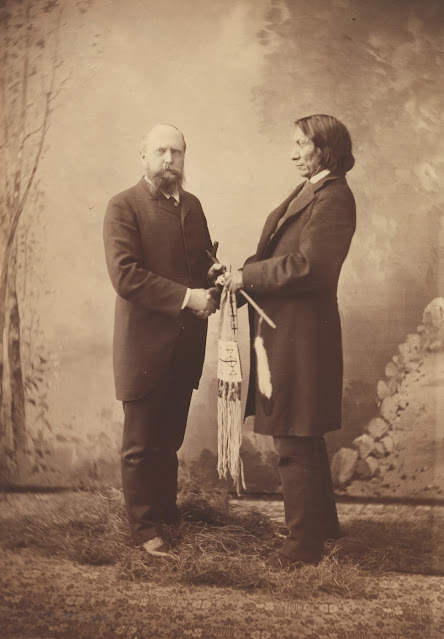It wasn’t gold the man was after. Made good sense that the Ogallalas were suspicious and angry. Made good sense they wouldn’t tolerate yet another white guy hanging around. They weren’t one bit taken with their presence.
What the white man was doing, he told them, was hunting for big bones. Some snickered.
That explanation didn’t help. Some white man coming into the heart of sacred land to look for bones of big four-leggeds who’d lived and died many winters before? Old bones they were digging, he said, not gold.
Red Cloud and his men were wary about him and all the gold white people swore was lying around, gold that turned them nutty as mules. They’d seen far too many white men swarming in, making promises they never kept, not once.
Red Cloud, the Ogallala Sioux headman, war hero, was skeptical, not thrilled. He didn't buy the whole "bones of ancient animals" madness. Besides, this strange white man was pushy and odd, even for a white man. From way out east, he told them. He talked funny.
It was early winter, 1874, in the very heart of the Badlands, the place the treaty at Ft. Laramie had said was now and forever Sioux country, and a crazy man--a professor from Yale—was trying to convince the Ogallala Sioux that he wouldn't mess with the ancestors' remains. He was doing something he called science, this man said, gathering bones of huge four-leggeds none of them had ever even seen--fossils, he called them.
White men never told the truth.
Picture it: a Lakota war party amid wasteland spires, jagged peaks, and weird wind-carved sandstone statues all around, a Twilight Zone so eerie travelers still today wonder who on earth created this world—and why?
Professor Othniel Marsh, the nation's foremost paleontologist, stood there stiff-necked, an Ivy Leaguer with a half dozen chippy students scared to death. In front of them stood the greatest Lakota headman and a war party in full regalia. No John Wayne Western ever posed such polar opposites.
Red Cloud had been to Washington, had seen white men thick as bats in a cave. Besides, he didn't need to look over his warriors to know his people were hungry. He must have told the professor how preposterous it was for him to ask them to believe him. He must have showed Professor Marsh their poverty, must have made clear that the treaty gave them nothing, no promised reparations. They were starving. His people were dying. Treaties were worthless. White men were liars.
The mad professor Marsh promised Red Cloud he would take their suffering to the Great Father, and somehow, that day in the Badlands, Red Cloud believed him, then warned him to gather his things yet that night and get away with those big bones--fossils, the professor called them. So Marsh and his students did as Red Cloud suggested, cleared out, headed back east.
When they got back the professor did exactly as he'd promised: he went to Washington, ignited a scandal in the administration of President Ulysses S. Grant, and thereby secured provisions for Red Cloud's Ogallalas. He kept his promise.
Now let's be clear. Professor Marsh could be more than mean-spirited. People who worked for him learned quickly to dislike him. Scholars today are convinced that were his tantrums diagnosed, a psychologist might say Othniel Marsh, the great paleontologist, would fit somewhere on the autism spectrum. But the mad Professor kept his Badlands promise.
The picture way up on top was taken 11 years later, when Red Cloud was, once again, taken out east, where he went to New Haven to visit the man he called "the Big Bone Chief" and present him with a peace pipe and a wampum belt, symbols of gratitude and friendship. "He told the Great Father everything just as he promised he would," Red Cloud said, "and I think he is the best white man I ever saw."
Still, less than a decade later, Big Foot and his band would come through the same rugged sandstone spires on his way to Pine Ridge, on his way to Wounded Knee.
There's always more to the story, isn't there?
But the story about big bones is too easily lost. It's a great Badlands story, right out of the Twilight Zone.

No comments:
Post a Comment